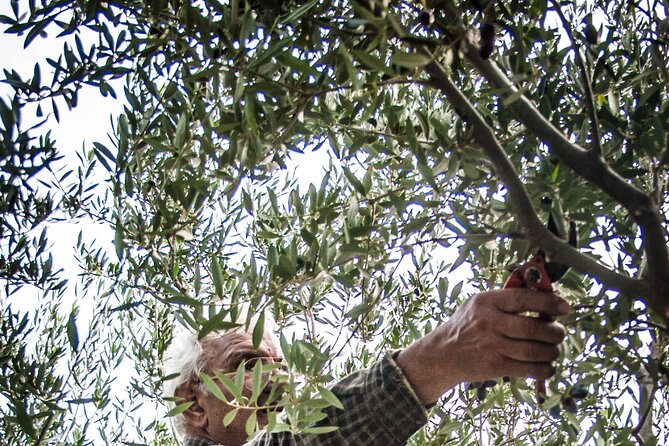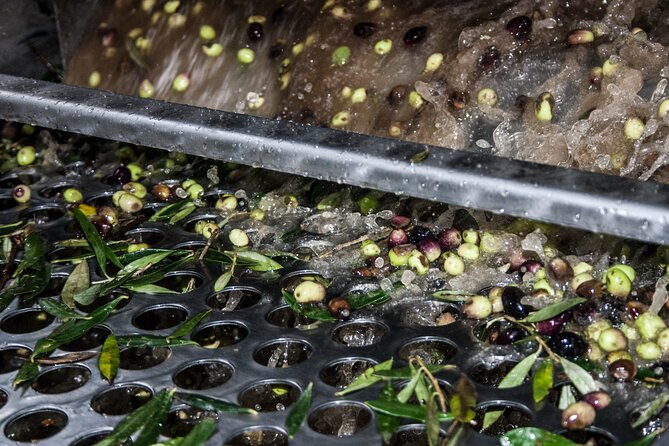Olive Harvesting in Eastern Mani
While some may see olive harvesting as a labor-intensive task, in Eastern Mani, it transforms into a captivating journey that transcends mere agricultural work.
The ancient olive groves of this region hold secrets waiting to be unraveled by those willing to enjoy the age-old tradition.
The allure of the olive harvest lies not only in the act of gathering the fruits but in the stories woven into each tree and the hands that tend to them.
As the sun sets over the rugged landscape, a deeper narrative emerges, inviting participants to discover the essence of Eastern Mani through its most cherished fruit.
Key Points

- Engage in traditional olive picking during peak ripeness in Autumn.
- Learn eco-friendly cultivation methods and witness the pressing process.
- Experience the aroma and taste of freshly pressed olive oil.
- Immerse in local culture through cooking workshops and centuries-old techniques.
Overview of Olive Harvesting Experience

Embarking on the olive harvesting experience offers travelers a unique opportunity to enjoy the traditional agricultural practices of Eastern Mani. Sustainable practices are at the core of this experience, where participants learn about the eco-friendly methods used for centuries to cultivate olives in this region. From handpicking the ripe fruits to witnessing the careful pressing process, visitors gain a deep understanding of the sustainable approach to olive farming.
On top of that, culinary experiences abound during the olive harvesting adventure. Travelers have the chance to taste freshly pressed olive oil, sample local dishes infused with the rich flavors of the region’s olives, and even participate in cooking workshops to learn how to incorporate this staple ingredient into traditional recipes. This immersive journey offers a delicious insight into the gastronomic delights of Eastern Mani.
Best Time to Participate

The ideal time to participate in the olive harvesting experience in Eastern Mani is during the autumn months when the fruits are at peak ripeness. This period, typically from late September to early November, offers the best opportunity to engage in the traditional practice of olive picking while immersing oneself in the local culture. During the peak season, participants can witness firsthand the centuries-old techniques passed down through generations, gaining a deep appreciation for the importance of olives in the region.
| Best Time to Participate | Peak Season | Cultural Immersion |
|---|---|---|
| Ideal Time | Late September | Deeply Engaging |
| Peak Ripeness | Early November | Traditional Methods |
Essential Equipment Needed
Participants in the olive harvesting experience in Eastern Mani should ensure they’ve the necessary equipment to fully engage in the traditional practice.
- Equipment Checklist:
- Sturdy gloves to protect hands from thorns.
- A reliable hand rake for gathering olives efficiently.
- Comfortable and durable footwear for traversing the rugged terrain.
- A wide-brimmed hat to shield from the sun.
- Plenty of water to stay hydrated throughout the day.
Proper attire is crucial for a successful olive harvesting experience, ensuring participants are comfortable and protected while engaging in this ancient tradition. By adhering to this equipment checklist and dressing appropriately, you can fully enjoy the olive harvest, enjoying the beauty of Eastern Mani while contributing to this time-honored practice.
Techniques for Harvesting Olives
Before venturing into the olive groves of Eastern Mani, understanding the proper techniques for harvesting olives is key to a successful and rewarding experience. Modern tools play a significant role in simplifying the harvesting process, with equipment such as mechanical shakers making it easier to efficiently collect olives from the trees. These tools help reduce the labor-intensive nature of olive harvesting, allowing for a more streamlined operation.
Along With using modern tools, sustainability practices are increasingly being integrated into olive harvesting methods. Farmers are implementing techniques to minimize waste, reduce water usage, and promote biodiversity in the groves. By combining modern tools with sustainable practices, olive harvesting in Eastern Mani not only becomes more efficient but also environmentally friendly.
Traditional Olive Processing Methods
Utilizing age-old methods passed down through generations, locals in Eastern Mani expertly employ traditional techniques for processing olives, infusing each step with a rich cultural heritage.
-
The rhythmic sound of stone olive presses crushing the fruit echoes the hard work and dedication of the locals.
-
The aroma of fresh olive oil permeates the air, a sensory experience that connects the past with the present.
-
Skilled hands carefully pack the crushed olives into woven baskets, preserving a tradition that binds families together.
-
Tasting the first drops of newly pressed olive oil is a moment of celebration, marking the culmination of a year’s labor.
-
Each step in the olive processing journey reflects a deep respect for nature and a profound connection to the land.
Local Culinary Delights to Enjoy

Enjoy the vibrant flavors of Eastern Mani by savoring the array of local culinary delights awaiting your palate.
Tasting sessions offer a unique opportunity to dive into the region’s rich gastronomic heritage, allowing for a true culture.
Delight your taste buds with food pairings that perfectly complement the regional specialties, such as Kalamata olives, extra virgin olive oil, and succulent lamb dishes.
Indulge in the freshness of locally sourced fruits and vegetables, paired with aromatic herbs and spices that capture the essence of the Mediterranean.
From traditional recipes passed down through generations to contemporary twists on classic dishes, Eastern Mani’s culinary scene promises an unforgettable experience that celebrates the bounty of the land and sea.
Sustainable Practices in Olive Farming
Exploring innovative methods for cultivating olives sustainably, local farmers in Eastern Mani prioritize ecological practices to ensure the longevity of their olive groves.
-
Respecting Nature: By implementing sustainable practices, farmers show deep respect for the environment and their ancestral lands.
-
Promoting Biodiversity: Encouraging diverse ecosystems within olive groves helps support local flora and fauna, enriching the environment.
-
Community Engagement: Involving local communities in olive farming activities fosters a sense of belonging and shared responsibility for the land.
-
Water Conservation: Utilizing water-saving techniques ensures efficient use of this precious resource, promoting sustainability.
-
Educational Initiatives: Educating future generations about sustainable farming practices secures a legacy of environmental stewardship in Eastern Mani.
Common questions
How Long Does the Olive Harvesting Experience Typically Last?
The olive harvesting experience typically lasts for a few hours. Participants engage in traditional harvesting techniques, fostering community involvement and a rich cultural experience. It offers an immersive look into the local traditions and the importance of olive cultivation.
Are There Any Age Restrictions for Participating in the Olive Harvesting Activity?
Age restrictions may apply due to the physical demands of traditional harvest practices. Understanding local harvest traditions is essential. It’s important to inquire about any specific age requirements before participating in the olive harvesting activity.
Is Transportation Provided to and From the Olive Farm?
Transportation logistics are handled by the tour operator. Accommodation options may be available. Local cuisine and sightseeing opportunities can enhance the overall experience. Guests can expect a well-rounded journey with convenience and exploration.
Are There Any Restroom Facilities Available On-Site During the Olive Harvesting Experience?
Restroom facilities are available on-site during the olive harvesting experience. Harvesting duration may vary based on group size. Be Melinas Guest, the operator, ensures a maximum of 6 travelers per session. Enjoy the experience!
Can Participants Bring Their Own Food and Drinks to the Olive Farm?
Participants can bring their own food and drinks to the olive farm. They have the freedom to choose their food options and drink preferences for the experience. Enjoying a meal amidst the olive trees can enhance the overall experience.
Last Words
As the sun sets over the olive groves of Eastern Mani, the timeless tradition of olive harvesting continues to thrive, bridging the gap between past and present.
The rhythmic rustle of branches, the earthy scent of fresh produce, and the shared sense of community create an immersive experience that celebrates tradition and sustainability.
Participants leave with a deeper connection to the land and its rich agricultural heritage, making each olive harvested a symbol of heritage and unity.